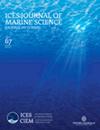模拟复杂沿海环境中的扩散:东岸群岛群岛
IF 3.4
2区 农林科学
Q1 FISHERIES
引用次数: 0
摘要
苏格兰大陆架上的东岸群岛(ESI)拥有丰富多样的生物栖息地和相关的沿岸物种。ESI 海岸线独特而复杂的几何形状对环流有重大影响,并相应地影响近岸生物的扩散。对于许多沿岸地区来说,能否准确地解析生物的扩散过程,取决于是否有能够解析细 尺度沿岸边界条件(包括海岸线和水深特征)的海洋学模式。我们在 ESI 中应用了高分辨率海洋环流模式和拉格朗日粒子跟踪技术来模拟近岸生物的扩散过程。我们的研究结果表明,西南-东北向的迁移与近岸逆向流有关。从长期来看,研究区域不同区域之间的传输主要由残余流决定,而在较短的时间尺度内,潮汐流则主导着粒子的扩散模式。对拉格朗日相干结构的分析发现,它们始终与海湾口相关联,这表明岛屿和相关的海洋学过程促进了自我滞留。这些结果突显了复杂的海岸线和相关的海洋学过程是如何促进滞留的,并强调了在估 计沿岸环境的生物物理扩散时,需要解决这些细尺度的物理和海洋学特征问题。本文章由计算机程序翻译,如有差异,请以英文原文为准。
Simulating dispersal in a complex coastal environment: the Eastern Shore Islands archipelago
The Eastern Shore Islands (ESI) archipelago on the Scotian Shelf supports a rich variety of biogenic habitats and associated diversity of coastal species. The unique and complex geometry of the ESI coastline has a significant impact on circulation and, correspondingly, influences the dispersal of nearshore organisms. For many coastal areas, the ability to accurately resolve the dispersal processes is contingent on the availability of oceanographic models that can resolve fine-scale coastal boundary conditions, including coastlines and bathymetric features. We applied a high-resolution ocean circulation model and Lagrangian particle tracking in the ESI to simulate dispersal of nearshore organisms. Our results revealed predominant southwest–northeast transport that was associated with a nearshore reversal flow. While transport among different zones of the study region is mainly determined by residual currents over the long term, tidal currents dominate patterns of particle dispersal over shorter time scales. An analysis of Lagrangian coherent structures found that they were consistently associated with the mouths of bays, demonstrating that the islands and associated oceanographic processes promote self-retention. These results highlight how complex coastlines and associated oceanographic processes promote retention and underline the need to resolve these fine-scale physical and oceanographic features when estimating biophysical dispersal in the coastal environment.
求助全文
通过发布文献求助,成功后即可免费获取论文全文。
去求助
来源期刊

ICES Journal of Marine Science
农林科学-海洋学
CiteScore
6.60
自引率
12.10%
发文量
207
审稿时长
6-16 weeks
期刊介绍:
The ICES Journal of Marine Science publishes original articles, opinion essays (“Food for Thought”), visions for the future (“Quo Vadimus”), and critical reviews that contribute to our scientific understanding of marine systems and the impact of human activities on them. The Journal also serves as a foundation for scientific advice across the broad spectrum of management and conservation issues related to the marine environment. Oceanography (e.g. productivity-determining processes), marine habitats, living resources, and related topics constitute the key elements of papers considered for publication. This includes economic, social, and public administration studies to the extent that they are directly related to management of the seas and are of general interest to marine scientists. Integrated studies that bridge gaps between traditional disciplines are particularly welcome.
 求助内容:
求助内容: 应助结果提醒方式:
应助结果提醒方式:


